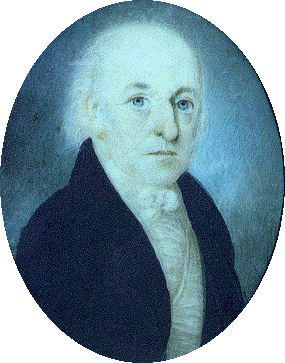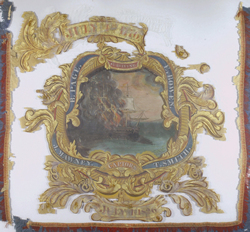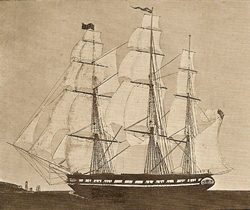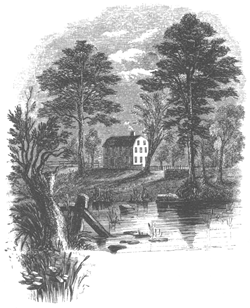Gaspee Virtual
Archives Virtual
Archives |
| Captain Benjamin Page (1753-1833) |
| The Gaspee Days Committee at www.gaspee.COM is a civic-minded nonprofit organization that operates many community events in and around Pawtuxet Village, including the famous Gaspee Days Parade each June. These events are all designed to commemorate the 1772 burning of the hated British revenue schooner, HMS Gaspee, by Rhode Island patriots as America's 'First Blow for Freedom' TM. Our historical research center, the Gaspee Virtual Archives at www.gaspee.ORG , has presented these research notes as an attempt to gather further information on one who has been suspected of being associated with the the burning of the Gaspee. Please e-mail your comments or further questions to webmaster@gaspee.org. |
| Biography of Captain Benjamin Page by Thomas E. Woodstrup Author of Captain Benjamin Page, A Forgotten Rhode Island Hero of the American Revolution, Rediscovered in Sycamore, Illinois. Special contribution by
the
author to the Gaspee Virtual Archives.
|
 Benjamin
Page, Sr., was born in
1753 and is believed to be a
descendant
of an early Rhode Island family that may have arrived with
Roger
Williams.
His father, Ambrose Page, was born in Providence, 1723,
was a sea
captain
during the Seven Years War, was a member of the Rhode
Island General
Assembly,
and had married Alice Smith. Benjamin
Page, Sr., was born in
1753 and is believed to be a
descendant
of an early Rhode Island family that may have arrived with
Roger
Williams.
His father, Ambrose Page, was born in Providence, 1723,
was a sea
captain
during the Seven Years War, was a member of the Rhode
Island General
Assembly,
and had married Alice Smith.
Left:
Portrait of Benjamin
Page, artist and
date unknown,
but probably c1826.
From the collection of Page family
descendants, Frank and Trudy Drew.
 Right: 1826
parade banner depicting the burning of the Gaspee. Surrounding the
picture are the names of the four then 'surviving
captors' who
participated in the
raid who were being celebrated: B. Page (upper left),
E. Bowen, T.
Smith, and J. Mawney. Courtesy of RI Historical
Society
RHiX17317. Click image
to
enlarge. Right: 1826
parade banner depicting the burning of the Gaspee. Surrounding the
picture are the names of the four then 'surviving
captors' who
participated in the
raid who were being celebrated: B. Page (upper left),
E. Bowen, T.
Smith, and J. Mawney. Courtesy of RI Historical
Society
RHiX17317. Click image
to
enlarge.He had met with his young friends at the Sabin's house that historical night: "Doc" Mawney, "Turp" Smith, "Eph" Bowen and Joe Bucklin. This same group marched in a Fourth of July parade years later. All, of course, could have been exposed and identified by the British after the Gaspee Incident. Page had a been a member of the Rhode Island Militia and was appointed captain of the first of the two row galleys which were later rigged as schooners. While John Paul Jones was ranked No. 18 of the first commissioned captains of the Continental Navy & Marine Corps, Page was ranked No. 18 among the first lieutenants. Perhaps that was the only association Page could have had with John Paul. He apparently never sailed under him and was not with Whipple when he sailed with Jones. Thus, Page, as did many others, stayed behind to defend the American continent, while Jones was away three years defending the European side of the Atlantic. (According to Illinois through two hundred and forty-five years, 1673-1918 pub by Chicago Hist Soc. one object donated to the exhibition by Capt. Benjamin Page was a marine spyglass used by John Paul Jones.--ed). Beside Captain Whipple, Page also sailed under Capt. Samuel Nicholson, Capt. John B. Hopkins, Jr., Capt. Dudley Saltonstall, Capt. Joseph Olney, Capt. John Manley and Capt. Hoystead Hacker. Page was several times a Third Lieutenant, a Second Lieutenant and finally became Captain of the Regulator in 1782 before the war ended. He had served on eight different ships, and at least twice with Whipple on the Providence. One historian placed Whipple as the most outstanding commodore of the then Continental Navy. Page was a prisoner of war three times: at Penobscot, MA/ME, with Paul Revere; at Charleston, SC, with Whipple; and quite likely at the Battle of Rhode Island. Page had served eleven years from the Gaspee Affair to the end of the Revolution in 1783. After the war, Page returned to Providence, but to continue farming he moved in 1824 to Massillon, Ohio. He was first married to Ann Sweeting and they had a son, Ambrose, who became a sea captain but apparently did not move with the rest of the family to Ohio. Benjamin then married Sarah R. Wamer and they had seven children: William W., Elizabeth W., John B., Oliver R., George W., Benjamin, Jr., and Henry Edward. William moved to South America and became a captain in the Argentinian Navy. John, Oliver and George all died in Ohio. Oliver married Margaret Caroline Troup and they had children. William married Micaela Paven and Henry married Elizabeth Pfaff. Captain Benjamin Page, Sr., died at age 80 in 1833 and was first buried near Massillon, it is believed, and later moved to the Westlawn Cemetery at Canton, Ohio. His son, Ambrose, is buried at the Old North Burial Ground at Providence, along with other members of the Page ancestry. Benjamin, Jr., and Henry retired and moved to Sycamore, Illinois, in 1853. They were later joined by Elizabeth who had married Senator David Austin Starkweather of Ohio. The family were among the first members of the Episcopal church in Massillon and also in Sycamore. Benjamin, Jr., was also a captain and was the last to die. He had had a monument erected in the Sycamore cemetery to all members of his father's family. From an inscription on this monument, "of the Amer. Rev." it was learned about Capt. Benjamin, Sr.'s, participation in the Continental Navy. Benjamin, Jr., his wife Mary D. Johnson, Henry and Mrs. Starkweather are all buried there. Because Benjamin, Jr., and Henry had no children, it was thought the Page family ended then westward progression in Sycamore. However, it was learned in 2000 that a descendant of Mrs. Starkweather's was living in Oregon. Sycamore is located in DeKalb County, another Revolutionary War name, and because it has little other relationship to the American Revolution, it is honored to have this association with the Gaspee Affair, with Gaspee Days, and Warwick, RI. For further information on the Page family, see Captain Benjamin Page, A Forgotten Rhode Island Hero of the American Revolution, Rediscovered in Sycamore, Illinois, by Thomas E. Woodstrup, 1998. Copies available through the Sycamore Historical Society at sychist@tbc.net |
| Webmaster's Addendum
So as to avoid confusion, note that there were othermen named Benjamin Page, such as one b26 May 1753 in Groton, MA. We'll also note that genealogical sources can be wildly off on dates and names. From a compilation of sources including the on-line sources of Ancestry.com, FamilySearch.org, Whipple.org, and the RI Historical Cemeteries Index, as well as the Page family genealogy and Thomas Woodstrup's book on Benjamin Page we deduce the following: Benjamin Page was born 22Mar1753 to Ambrose Page (1723-1791) as his father. His mother may have been Rhobe (Carpenter) Page--they had married 10July1743--, or Alice (Smith) Page (22Nov1733 - 13Mar1772). Ambrose Page was a well known merchant and mariner in Providence, RI, and Alice Smith was descended from some of the original founding families of Providence. Benjamin Page had 10 siblings or step-siblings including the following four; Job, Sally, Dorcas, and Molly. We suspect that Dorcas may have died young in 1771, and Molly may have died young in 1772 just before their mother Alice died. Ambrose Page then married Sarah (Jenckes) Hopkins (1733-1812) later in 1772. She was the widow of Captain Christopher Hopkins, nephew of Admiral Esek Hopkins Just why was Benjamin Page involved in the Gaspee raid? There are several explanations that come to mind. His father was involved in merchant shipping, and Ambrose was undoubtedly a compatriot of John Brown and like men interested in relief from the Gaspee's limitations on their smuggling operations of molasses, rum, and other goods. It is quite possible, although purely conjectural, that Ambrose Page himself was also along for the raid on the Gaspee. The 1770 List of Providence Taxpayers shows Ambrose Page's two adjoining properties located on the East Side neighborhood of Providence on the west side of North Main Street. His are the only Page properties listed on the map. So, we know that young Benjamin Page was living in the area when the men met to plot the attack on the Gaspee on June 9th, 1772. His family likely had a vested interest in getting rid of the British ship. What is also compelling is that he and many of his friends of a similar age were compatriots in the attack on the Gaspee, and many of many were related by blood. Finally, Benjamin Page's later long service in the Revolution gives testimony to his anti-loyalist leanings. Writing in An Empire on the Edge (2014), author Nick Bunker indicates that in October 1774 it was Captain Benjamin Page that sailed the ship, Smack, to the coast of Holland where he was intent on buying cannon, gunpowder, and other weaponry with which to arm the American colonies. This would clearly be an act of high treason, and British spies passed on this intelligence to the ministers of King George III, who became immediately alarmed at the prospect of the Americans arming themselves as if to prepare for war against the British. From HeritageQuest through the NEHGS portal we find our Benjamin Page's application for pension #S.3629 based on his service in the Continental Navy in the Revolutionary War, and his recollections are meticulous. He had been given a commission by the Rhode Island Navy 4Aug 1775 and was commander of a row galley, and resigned that commission 10Oct1776 and was given a Commission as a Lieutenant in the United States Navy, with orders to report aboard the frigate (actually an armed sloop--ed) Providence, commanded by Abraham Whipple, and served until 24Dec1777. He was then assigned to the frigate Warren, John B. Hopkins, commander, as Second Lieutenant until 14Jun1779. he then received orders under Commodore Dudley Saltonstall, was defeated at Penobscot (Maine) and was ordered to burn the trapped ships in Aug1779. 20Sep1779 he was assigned to the frigate Providence as First Lieutenant, which was captained by his previous commander, Abraham Whipple. After a cruise off of South Carolina in the winter of 1780 the small American fleet was sunk by the British in the region of Charleston in May 1780. We know that Commodore Whipple and other officers were kept as prisoners-of-war until war's end (see page on Abraham Whipple), but Benjamin Page claims to have "obtained my parole" (prisoner exchange). 13Sept1781 he received orders to frigate Deane, Captained by Samuel Nicholson until 10May1782. Benjamin Page was then given command of the armed sloop, Regulator, 20 guns on 25Sept1782, but was then ordered aboard the frigate Hague, Captain Hanley, as First Lieutenant and served until the cessation of hostilities on 16Sept1783. He was 68 years old when he initially applied for his pension on 22Mar1818 in Rhode Island. He did receive some sort of a pension beginning in 1819, but reapplied from Cleveland, Ohio under the newer pension acts of Congress and received his increased pension in 1831  Left:
The Ann
& Hope,
commanded by Captain Benjamin Page, on its first
trip to China . From an old painting commissioned
by Brown & Ives. Left:
The Ann
& Hope,
commanded by Captain Benjamin Page, on its first
trip to China . From an old painting commissioned
by Brown & Ives.The following snippets are from the Early American Newspapers Collection obtained through the NEHGS portal, mostly the Providence Gazette. In July 1784 Capt. Benjamin Page arrived from Amsterdam, and in 1785 commanded the brig Providence to Jamaica. In 1787 he arrived in Providence from Martinico in the brig Hope, and in 1791 he arrived from India in the Hope. From March 1792 to October 1793 he sailed the Hope to and from Canton, China, and in 1795 he commanded the Halcyon to Canton. In July 1798 he took command of "the new and elegant coppered ship" Ann and Hope for Canton, with a crew of sixty, and armed with twelve 9 pounders, and returning in June 1799. Note that both the Hope and the Ann & Hope were owned by Gaspee raid leader John Brown's mercantile and shipping firm of Brown & Ives. It is obvious that John Brown considered him one of his most trustworthy and capable captains, and it is, therefore, also quite possible that Benjamin Page was along on some of John Brown's earlier slaving expeditions that defined the Triangular trade. It is to be pointed out that, as of this date, we have no evidence of this whatsoever. A new avenue of Benjamin Page's maritime pursuits is being investigated by an Australian, Dan Brynes, who writes: We
find meantime, that one of your Gaspee
raiders was Capt. Benjamin Page,
who several times in the 1790s called to Sydney
while he was sailing
ships owned by John Brown
(or, Brown and
Ives) of Rhode Island. I
should explain that our standard Australian
shipping registers have
only highly-abbreviated information on ship
arrivals and departures,
Brown and Ives ships are noticed, but in
ultra-sketchy ways... .
From History of Providence County (New York: W.W. Preston & Co., 1891), p176: "Benjamin Page was a prominent shipmaster, and for many years commander of a ship in the East-India trade" The author also says that Page Street in Providence was probably named after Benjamin Page, whose estate was upon the corner of Potter and Broad streets, but this may have been just as likely his father, Ambrose Page. Benjamin Page was listed in 1790 census as living in North Providence, RI. In either event, Benjamin Page was married first to Ann Sweeting (born c1764 in Rhode Island) with whom he had two sons, Ambrose S. Page, (c1794-c1851) and William W. Page, (c1798-after 1852). Benjamin's first wife Ann Sweeting Page died 22Mar1799 and it can be surmised that perhaps she died as a result of giving birth to William W.  We
see no further
mention of Benjamin Page's maritime exploits and he
probably
retired from the sea after this last voyage to China
in 1799 when he
got
married to his second wife, Sarah Reed Warner
(25Mar1776 - 6Mar1849).
This marriage
may have been as much out of necessity as out of
romance.
Marriage at the time was an economic imperative, and
Captain Page had
two young sons to care for, so it was not unusual to
be married again
within a half-year of the previous spouse having
died. As
noted above, they went on to have many children, and
in 1803 they
purchased a stately farm house in
Portsmouth, RI previously owned by British loyalist,
Henry John
Overing. This
house had been
used by the British General Prescott as
quarters when the British occupied the island
during the Revolutionary
War. As widely reported in the local
newspapers
in 1828,
the Pages were visited at this home by American
war
hero General
William Barton, who
had effected the commando raid that captured
General Prescott during
the
preliminaries to the Battle of Rhode Island in
1777 (See
further details). The house still exists
adjoining the Prescott
Farm
Museum on the Middletown-Portsmouth,
RI line. We
see no further
mention of Benjamin Page's maritime exploits and he
probably
retired from the sea after this last voyage to China
in 1799 when he
got
married to his second wife, Sarah Reed Warner
(25Mar1776 - 6Mar1849).
This marriage
may have been as much out of necessity as out of
romance.
Marriage at the time was an economic imperative, and
Captain Page had
two young sons to care for, so it was not unusual to
be married again
within a half-year of the previous spouse having
died. As
noted above, they went on to have many children, and
in 1803 they
purchased a stately farm house in
Portsmouth, RI previously owned by British loyalist,
Henry John
Overing. This
house had been
used by the British General Prescott as
quarters when the British occupied the island
during the Revolutionary
War. As widely reported in the local
newspapers
in 1828,
the Pages were visited at this home by American
war
hero General
William Barton, who
had effected the commando raid that captured
General Prescott during
the
preliminaries to the Battle of Rhode Island in
1777 (See
further details). The house still exists
adjoining the Prescott
Farm
Museum on the Middletown-Portsmouth,
RI line.
Right: The Overing House in Portsmouth RI, wherein British General Prescott was captured in 1777, later the residence of Captain Benjamin Page. From Lossing's Pictoral Field Guide to the Revolution, 1859. Benjamin's second wife Sarah
(sometimes
recorded as Sally) may have been from a
well-heeled Newport
family; the deed to the farm was purchased in Sara
Warner Page' s name
only, but perhaps this was to limit Benjamin Page's
discoverable
assets. We
know from land records that Benjamin Page mortgaged
his home shortly
after its purchase, but the entirety was paid off
within a year.
Despite the
worldly
holdings expected of a retired sea captain, he
claimed indebtedness,
possibly to
bolster his pension claim in 1818. As
part of the supporting documents for
his pension application,
there
appears to be a complete inventory of Benjamin
Page's holdings as of
March 1818
valued at a total of only $684. He also lists his
dependents and their
ages at that
time as being: his wife 44, and his mother 81, (but
this must've been
his mother-in-law since his biologic mother died in
1772). Children
were listed as: John B. Page 17 (therefore, born
c1801), Oliver W.
Page 14 (c1804), George N. Page 12 (c1806), Benjamin
Page, Jr 10
(c1808), Henry H. Page 7 (c1811), and
a servant (name indecipherable) of 8 years. He
also listed
Ambrose Page, 24 (c1794), at sea, and William W.
Page, 20 (c1798). We do not know with certainty what
sort
of farming was carried on at the Page farm in
Portsmouth. The
previous owner was heavily involved in sugar
refining, and it is
possible that distillery-related operations were
carried on
there. In
1852,
in Ohio, Benjamin Page, Jr. made claim for the
pension payments that
had
been in arrears. He also gave a note indicating that
the widow of Capt.
Benjamin Page died 6March1849, and that his parents
had been married
in Providence, RI 19Sept1799. Further papers
list the surviving
children as: Ambrose S. Page, John B. Page,
Elizabeth W. Page (by then
married to David Starkweather), Oliver R. Page,
Benjamin Page, Jr,
Henry E.
Page, and William W. Page. John B. Page died in 1839 with no
heirs, Oliver R. Page also died in 1839 (leaving
Mary, William, and
Alfred), Ambrose Page died in 1851 with no
children. William W.
Page went to Argentina in 1824 and served as a
Captain in the
Argentinian Navy in the War against Brazil until
1832, he married a
Micaela Pevon in 1827 and had one son that emigrated
to Chile.
Benjamin Page, Jr later died in 1887 in Sycamore,
IL. Unfortunately,
nothing in the pension paperwork relates to Benjamin
Page's
involvement with the burning of the Gaspee in
1772. We
found
through the Early American Newspapers Collection a
marriage
notice of
5July1835 at
Detroit of David A. Starkweather, Esq., lawyer, to
Mrs. Elizabeth W.
Evans. Apparently, this was her second
marriage.
According to the Biographical
Directory
of the US Congress, David Starkweather
(1802-1876) was an
Ohio State Senator who went
onto the US House of Representatives, and was later
a US
Envoy to Chile. Orel Lea further writes. We are also
proud of his later achievements as one of the
first Mariners to
sail from
Ore Lea and her sister Kylie Moore paid a visit to Rhode
Island in
2009, where they were formally indicted for the crimes of
their
ancestor, Benjamin Page, against King George III.
While here they
were also able to tie up some geneaological strings:Benjamin Jnr b.
1783,
was the son of Esther Seaver, Benjaminís 1st
wife, and he
was the lawyer who died in 1808 of a fever, in
Georgia.
For an Australian-centric biography of the Benjamin Page and his descendants view A Page in History by Orel Lea --(a work in progress)..,,,[Err, I mean the paper is a work in progress, not Orel] |
| The Gaspee Days Committee recognizes Captain Benjamin Page as a true American hero for his role in the attack on the HMS Gaspee in June of 1772. |
Additional
Sources:
|
| Return to Top | Back to Gaspee Virtual Archives |
 Benjamin
Page was just 19 years old at the time of the Gaspee
Affair.
His mother died nine days before this birthday. The Page
family were
sea-goers
with operation of a small farm on the side. They were
related to and
friends
of the Providence families of
Benjamin
Page was just 19 years old at the time of the Gaspee
Affair.
His mother died nine days before this birthday. The Page
family were
sea-goers
with operation of a small farm on the side. They were
related to and
friends
of the Providence families of